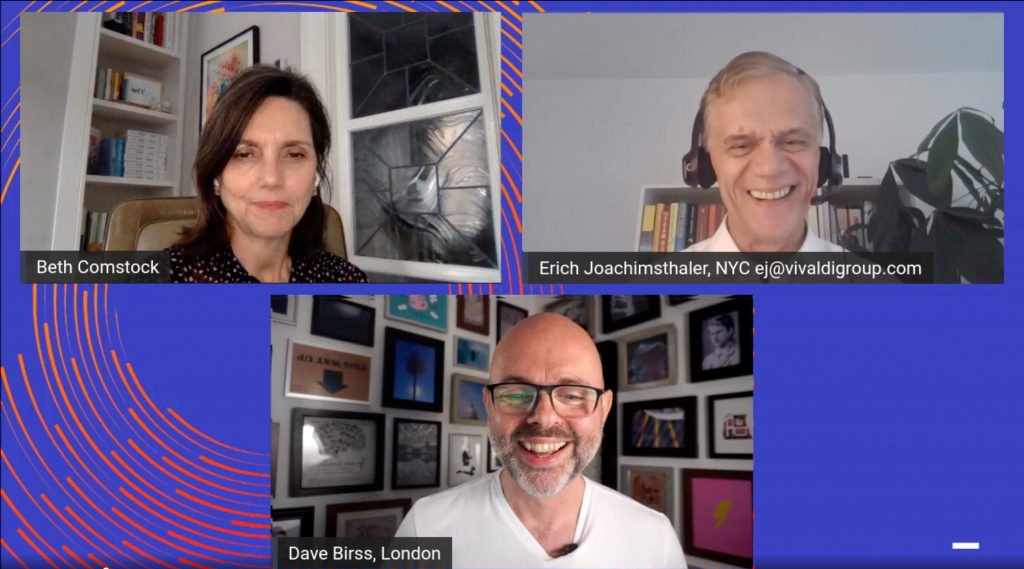Mastering change in the face of uncertainty can be startling. However, a strategic and future-facing approach, and the ability to embrace smart risks can make the transition seamless. Beth Comstock, former Chief Marketing Officer and Vice-Chair of Innovation at GE joined our CEO, Erich Joachimsthaler, to discuss how to grapple with the challenges to change we face every day, seeking out emerging trends and the importance of creating an effective ecosystem. Beth shared advice on finding the courage to defy convention and building the resilience to overcome failure.

Here are some key principles from Beth Comstock:
- There is great power in learning to adapt to the change. Getting accustomed to and making progress during periods of change requires a mindset shift that must happen on both a personal and cultural level. There is a common notion among bigger organizations in assuming they have the answers and the readiness that will allow them to bend change to their will. This is false and can hamper growth.
“Covid-19 has been a great teacher. It has helped us realize that we are not in control and we never really were, which has cultivated a thinking that allows greater willingness to try new things.” – Beth Comstock
- Best leaders in times of change are ambidextrous leaders. Beth says the secret to unlocking success during times of crisis is to have your company operate at two speeds. She draws a distinction between them as the ‘now lane’ and the ‘what’s next’ lane, also known as the ‘imagination lane.’ While the ‘now lane’ focuses on the current climate and trends, which is more predictable for bigger public companies, the ‘what’s next lane’ guides the future.
“It takes courage in supporting something for which you’re not exactly sure what the profitability model is, but you know there’s a hunger and you want to take it to the next level” – Beth Comstock
A good leader understands that they must operate both ways. They must allocate the time, people, and money while also evaluating what they learned, what they need to do more of, and how to put a halt on things that aren’t serving the company anymore.
3. Innovative companies help customers get to what’s next. Beth cites Nike as an example of an innovative and prescient company. Nike is constantly focused on listening to their customer and being passionate about delivering for them. They accomplish this by staying ahead of their customer, instead of waiting for them to tell them what they need. In most cases, customers often expect brands to know their needs before they do. Beth also attributes an ecosystem approach and strong integration of physical and digital to stay attuned to customer needs.
“To really be a platform company, it is recognizing that interconnectedness and knowing how to navigate it and digital forces you to do that. If a company was slow in digital, they’re not going to come out of Covid-19 and succeed being slow. Digital is just the way you have to operate.” – Beth Comstock
Here are the three simple steps to become a better marketer and innovator:
- In order to make a breakthrough innovation that you live to see tomorrow, you must be curious and open your aperture. The notion of discovery and making that a part of your practice is critical not only for your team but also for yourself.
- Mastering the art of storytelling is imperative in order to translate your vision to your team. Storytelling and strategy go hand in hand and your team should be able to discern that there is room for them in the company’s vision to be a part of it. Having a strong future vision entails being able to communicate to your team and audience both ‘the why,’ and ‘the why us.’
- To be a good marketer, one must live in the market. Beth recommends getting into the practice of maintaining a notebook or making notes on your phone to collate interesting ideas when out and about. This allows you to adopt the mindset of a marketer and develop a knack for pattern recognition.
Conclusion
Change is inevitable. It can be difficult to predict and always be prepared, but the willingness and swiftness to adapt to the change are crucial. In order to pave a successful future path, companies must look ahead of the moment and their current processes to optimize productivity. These often result in a gap of imagination and failure to envision what could disrupt them. It is necessary to outgrow mind blocks and see beyond the now to ultimately imagine a way forward.
Watch the full event here:
06:58: How to adapt to change
08:31: How to overcome the gap in imagination
11:17: Importance of curiosity and discovery
15:15: What we can learn from Walmart and Nike
20:42: Role of a good leader
23:23: What makes a good marketer
29:38: What is in Beth’s notebook
36:20: Brand’s role in positioning and scaling subcategories
40:43: The tension between branding and innovation
This segment was part of The Interaction Field Series of our LinkedIn Live Events. Please connect with us on our LinkedIn page to stay updated with our upcoming conversations.
